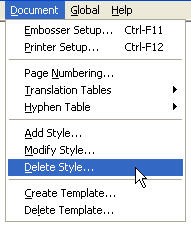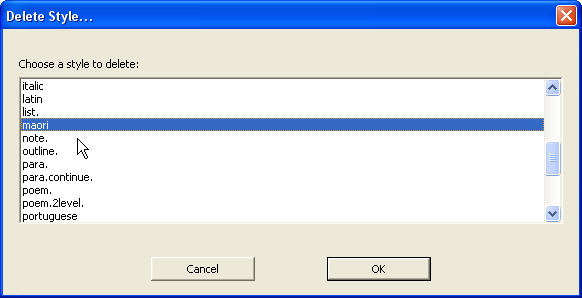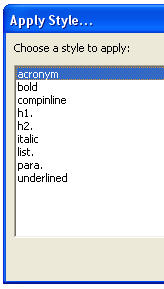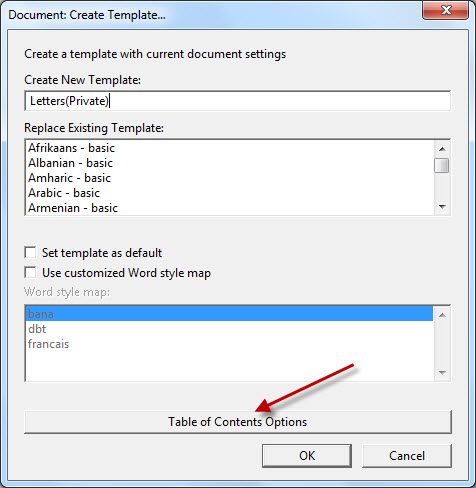
Templates hold a great deal of information, and in many instances, much of this information may not be required on a day to day basis. Or, the extensive list of styles available could be a lot to work through. You can customize a template to create one that is more convenient to your own work.
Remember also that the template serves as the framework for a document, and therefore the contents of the template are transferred to each document you create.
The following is simply a basic guide to what you can change. You may be directed to other topics for more detailed information. However, hopefully this will serve as a general check list. Note that the following discussion basically follows the contents of DBT's Document Menu.
Text can be stored in a template, including any required styles and codes that should accompany that text. For example, you may wish to create a letterhead template, a newsletter template, or any other purpose designed document or form.
If you have set up your system to use more than one embosser, or perhaps, have set up two or more configurations for the same embosser, you may choose to have your template use a specific embosser configuration. Select the Brailler Device you wish to use from the Document: Embosser Setup dialog. And may we emphasize the Document menu, not the Global menu.
If you do not specify a Brailler Device from the Document menu, then the system will automatically use whatever embosser is set as the default in Global: Embosser Setup at the time you save this template.
For more details, see "Document: Embosser Setup"
If you have more than one ink printer available, you may specify via the Document: Printer Setup dialog which one should be the default when printing a hard copy of your document. Again, may we emphasize the Document menu, not the Global Menu.
If you do not specify a printer at this point, then the system will automatically use whatever printer is set as the default printer in Global: Printer setup.
For more details, see "Document: Printer Setup".
If you have special page numbering requirements for the type of document defined in your template, you can define it now. For example, you may not wish to number the first page of a letter.
For more details, see "Document: Page Numbering".
You can change the translation table you are using.
For more details, see "Document: Translation Tables".
There are occasions when you may wish to change the default Hyphen Table.
For more details, see "Document: Hyphen Table".
You may find that you need a new style to solve a particular problem. For example, you may want a style which vertically centers text on the first page.
For more details, see the topics under "Templates, Styles & Codes."
DBT's styles may not always be as we want them. For example, in our letterhead template, we might require blank lines between paragraphs, where in other types of document, we may not. Hence we can modify the styles of the template to suit.
For more details, see "Modify Style" and "Templates, Styles & Codes".
Note: Many of DBT's importers use styles from the standard templates. A style may not appear to be important, but it could become painfully apparent later that it has a useful purpose.
You can delete styles which you are sure you will not use. Go to the Document menu as shown below, and click on "Delete Style" or press d.

The following dialog will appear.

Select the style you wish to remove, and press the OK button. The style you highlighted will be removed from the list, and you will be returned to the main DBT screen.
Repeat this process for each style you wish to remove.
Note: Some styles will be obvious to you. For example, if your template will only ever be used to produce English braille, you can most likely delete all language styles such as Maori, Latin, etc. If you are unsure about deleting a particular style we recommend that you do not. You can always delete it later.
The net result will be apparent when you next use your customized template and apply a style. The following example shows the Apply Style list as it might be if we were to produce a template for very simple letters. It shows just 9 styles.

If you wish to use a Custom Table of Contents (TOC) for your template, click on the "Table of Contents Options" button when you open the Create Template dialog. (See illustration below.) TOC options are available for both print and braille documents.
A full explanation of the TOC dialog can be found in Layout: Generate Table of Contents.

Templates can save you a lot of work, and make creation of new documents a far easier process. A little time spent now can save hours of work later.
Remember that you can always come back and modify a template at a later stage.
1) Open a new document, selecting the template you wish to modify.
2) Make your modifications (mostly using the commands of the Document menu) as described.
3) When you are happy with the changes, select Create Template. Highlight the template name which you selected initially. When you click the OK button, you will get a warning asking if you wish to overwrite the existing template. Click Yes.
Please, be aware that ...
As a rule, you cannot modify the templates supplied with DBT. However, you can save a standard DBT template to a custom version, and you can even use the original template name. Because the custom template is written to a separate folder, the original DBT template will not be changed. Then, because the custom folder is checked first when the list of DBT templates is created for display, the custom version of a template is used when the custom file and the standard template have the same name.
There can be good reasons to re-use the original template name when you make a custom version of a template. (One example occurs when DBT is working with the Duxbury NimPro program.) At other times, though, you may find that using a distinct name is preferable.